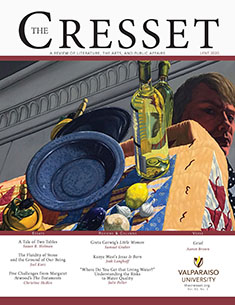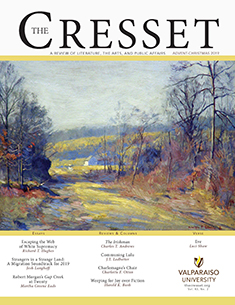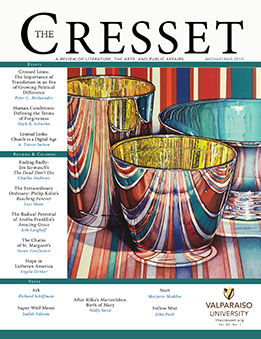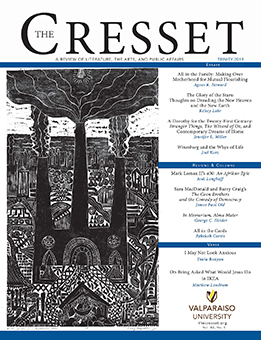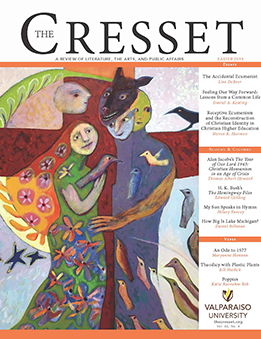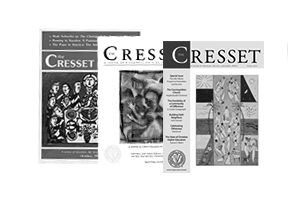The facts, though, seem impressive enough. The total world population in 1900 was 1.6 billion; Muslims numbered just below 200 million, and Christians 558 million. In 1970, the total world population was 3.7 billion with a Muslim population of 549 million and Christians at 1.2 billion. In 2006, Muslims numbered 1.3 billion and Christians 2.15 billion, including 1.3 billion Catholics. In less than forty years, the number of Christians in the world had nearly doubled, and Muslims had more than doubled (World Christian Encyclopedia 2001, vol. 1, 12ff).
The statistics for one twelve-month period at the early phase of the recent return of religion showed that twenty-five million people changed their religious affiliation, of whom eighteen million were converts to Christianity, and seven million defectors from Christianity to other religions, making Christianity the most active and most diverse religious frontier in the world (Encyclopedia Britannica World Data, 1992; on diversity, see Sanneh and Carpenter 2005).
Religious expansion in Africa entered its most vigorous phase following the end of colonial and missionary hegemony. In 1900, the Muslim population of Africa was 34.5 million, compared to roughly 8.7 million Christians, a ratio of 4:1. By 1985, Christians outnumbered Muslims in Africa. Of the continent’s total population of 520 million, Christians numbered 270.5 million, compared to about 216 million Muslims. By 2000, Christians in Africa had grown to 346 million, and Africa’s 315 million Muslims were concentrated mostly in the Arabic speaking regions of Egypt and in north and west Africa. Projections for 2025 are for 600 million Christians and 519 million Muslims in Africa. The Christian figures represent a continental shift of historic proportions.
Europe (including Russia) and North America in 1900 had a combined Christian population of 423 million—82 percent of the world’s Christians— compared to 94 million for the rest of the world. By 2005, Europe and North America accounted for only 35 percent of the world’s Christians; their 758 million Christians were far fewer than the 1.4 billion in the rest of the world. Thus, 65 percent of the world’s Christians now live in the southern hemisphere and in East Asia, areas that have become Christianity’s new stronghold. Increasingly, Europe is a new Christian margin.
Charismatic Christianity has been the driving engine of this expansion and is largely responsible for the dramatic shift in the religion’s center of gravity. In 1900 there were 981,000 Pentecostals; in 1970, over seventy-two million; and in 2005, nearly 590 million. The projections are that by 2025, Pentecostals/ Charismatics will number nearly eight hundred million. Now exploding in Brazil, Mexico, Russia, and China, Pentecostal Christianity may become the most widespread form of Christianity, with as yet unquantifiable effects on mainline churches and on global politics (Bays 1995).
As David Martin has shown, in Latin America the prominence of women Pentecostals has affected the machismo culture of the traditional military establishment (Martin 1990; see also Freston 2001). Female politicians draw on the energy of the Pentecostal movement to effect social change. Pentecostalism is also riding a wave of Latin American demographic changes, including immigration into the United States. Of the thirty-seven million Latino immigrants in the United States, the vast majority are Pentecostals, in both Catholic and Protestant denominations (see World Christian Encyclopedia 2001, vol. 1, 191–198; Burgess and Van Der Maas 2003, 286ff). The convergence of these immigrant Pentecostals with native US evangelical groups, such as the Christian Coalition, health-and-wealth gospelites, and the burgeoning mega-church phenomenon, has raised the political stakes in mainstream America and impacted the evangelical missionary agenda (See The Economist, “In the World of Good and Evil,” 14 September 2006; On US evangelical missions abroad see Brouwer, Gifford, and Rose 1996, Gifford 1995, 1998, and 2004).
While Latino Pentecostals have some things in common with US evangelicals, other branches of post-Western Christianity find themselves at odds with Christians in the West. Splits in the Anglican Communion over appointing gay clergy have turned into confessional shrapnel with global range. The historic GAFCON (Global Anglican Future Conference) meeting in Jerusalem in June 2008 brought together at very short notice more than 1,200 conservative bishops and others leaders, many of whom were from “Global South” Anglican provinces in Africa and South America. The Jerusalem agenda was dominated by pilgrimage trips to holy sites: the Mount of Olives, Gethsemane, the Temple Mount, and Galilee. In plenary sessions the participants were led in devotions, hymn singing, Bible study, prayer and supplication. The leaders spoke with respect and regret about the rupture of faith and order in the church, and asked for prayer for the impending Lambeth Conference of July 2008. A spirit of joy and thanksgiving suffused the conference as participants reflected on what it meant to visit the holy sites and to walk where Jesus walked and to see where he was tried, arrested, and crucified. Pilgrimage assumed a potent force for these post-Western Christians, loosening Christianity in their minds from its captivity in the West. The fact that they were on holy ground gave them the confidence to disavow spiritual tutelage under the West. That confidence manifested itself in charismatic prayer and devotion, suggesting that charismatic influence is probably as much of a concern for American Episcopalians as the homosexuality issue.
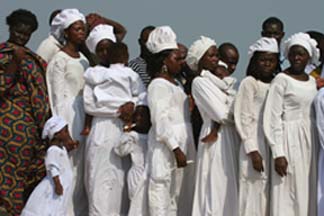 The Christian resurgence
has coincided with the emergence of radical Islam to upset calculations on a
different front, creating uncertainty and instability with the outbreak of new
cultural tensions and conflicts. Philip Jenkins, for example, sees a double
jeopardy in the potential for the onset of new Crusades and a cultural clash
with liberal Christianity (Jenkins 2002). The West is at a crucial crossroad in
its relations with Islam, and it has been weighing its options, as shown by
Pope Benedict XVI’s
Regensburg comments about the role of forced
conversions in Islam. The issue is not new, even though the consequences of
misunderstanding are today far more serious. When in the 1740s Frederick the
Great of Prussia formed the first lancer unit from Tartar Muslim deserters from
the Russian army, he did so out of his commitment to Enlightenment ideals of
religious toleration. Frederick
allocated a prayer room for the use of Muslim troops, but only on Sundays! Less
clumsily, he later had a Muslim cemetery built in Berlin. Through ups and downs, the Muslim
community survived in Germany.
Recently, a more radical form of Islam has spread across national boundaries.
Perhaps even more disconcerting is the fact that this new, more threatening
form of Islam has become implanted in areas of economic prosperity and mobility
in the West, defying arguments focused on deprivation, geographical alienation,
and lack of access as reasons for its emergence. Max Weber observed that Islam
is not a religion of salvation, and so he dropped it from his theory of
modernization (Weber 1978 vol. i, 625, and vol. ii,
1076, 1096-7, 1183). Yet he did not on that account predict that Islam would
have no future, which suggests that Islam’s future will diverge from the
secularization scenario.
The Christian resurgence
has coincided with the emergence of radical Islam to upset calculations on a
different front, creating uncertainty and instability with the outbreak of new
cultural tensions and conflicts. Philip Jenkins, for example, sees a double
jeopardy in the potential for the onset of new Crusades and a cultural clash
with liberal Christianity (Jenkins 2002). The West is at a crucial crossroad in
its relations with Islam, and it has been weighing its options, as shown by
Pope Benedict XVI’s
Regensburg comments about the role of forced
conversions in Islam. The issue is not new, even though the consequences of
misunderstanding are today far more serious. When in the 1740s Frederick the
Great of Prussia formed the first lancer unit from Tartar Muslim deserters from
the Russian army, he did so out of his commitment to Enlightenment ideals of
religious toleration. Frederick
allocated a prayer room for the use of Muslim troops, but only on Sundays! Less
clumsily, he later had a Muslim cemetery built in Berlin. Through ups and downs, the Muslim
community survived in Germany.
Recently, a more radical form of Islam has spread across national boundaries.
Perhaps even more disconcerting is the fact that this new, more threatening
form of Islam has become implanted in areas of economic prosperity and mobility
in the West, defying arguments focused on deprivation, geographical alienation,
and lack of access as reasons for its emergence. Max Weber observed that Islam
is not a religion of salvation, and so he dropped it from his theory of
modernization (Weber 1978 vol. i, 625, and vol. ii,
1076, 1096-7, 1183). Yet he did not on that account predict that Islam would
have no future, which suggests that Islam’s future will diverge from the
secularization scenario.
Religion in China: Repression and Reemergence
The religious awakening appears to have spread to China—a surprising vector given the country’s thoroughgoing program to eradicate religion. In 1949, the year of the triumph of Mao Tse-Tung’s Marxist-Leninist revolution—the church’s 9/11, you might say—there were about four million Christians in China, divided between three million Catholics and one million Protestants. Mao’s antagonism to foreign agents did not spare Christianity, except briefly in the Hundred Flowers Period which opened in May 1956. But a year later, in June 1957, that leniency was abruptly revoked as the Great Leap Forward campaign was launched. Buddhist, Christian, and other religious institutions were hit by new restrictions, with religious leaders becoming ever more entangled in the overweening thicket of official decrees directed at them. In the Great Proletarian Cultural Revolution starting in 1966, seventeen million urban youths known as the Red Guards were deployed to stalk the countryside. They wreaked widespread havoc, sacking ancient Buddhist temples and Christian churches. Alarmed by the excesses of the Red Guards, Mao tried in vain in 1968 to rein them in. Their uprising was not quelled until 1976; by then religions in China had retreated to the netherworld of secret meetings, house worship, home Bible study, and nocturnal assemblies.
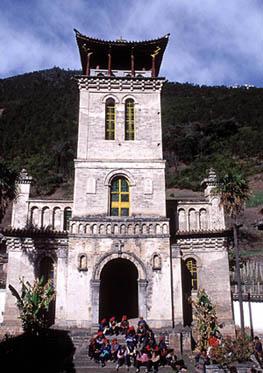
It did not occur to most observers that religion might have a future in China. Official Chinese policies about religion, however, began to vacillate and show cracks through which the wind of change was blowing. Party cadres, now less starry-eyed about Mao and less doom-and-gloom laden about religion, had come up for air. Beholding a mesmerizing world of material affluence beckoning on their horizon, they began to relent. At the beginning of the government’s liberalization program in 1978, Deng Xiaoping announced an easing of restrictions on religion. The following year, to universal astonishment, Deng roused the Chinese Communist Party to “seek truth from facts”—code for deserting Mao’s legacy. This initiative opened the way for the return of religion. Religious institutions felt vindicated for not having hauled down their colors, and piped to the new generation in the airs of Marxist-Leninist liberation, in the hope that communists would dance.
As the flood receded, the rock reappeared. Churches bounced back as the government made good on promises of restitution for properties seized and wrongs committed. In the revised constitution of 1982, religious rights were reaffirmed under Article Thirty-Six, followed by the publication of Document Nineteen concerning religious policy in China. The document essentially repudiated the excesses of the Great Cultural Revolution against religion as a “leftist mistake.” Churches must be rebuilt, clergy educated, and believers protected, the declaration said. Some 4,000 Protestant and 2,000 Catholic churches were reopened or rebuilt (Pro Mundi Vita Studies 1990). It did not take long for high-ranking officials to declare open sympathy for religion, and by 1986 the thaw had created a stream of official endorsements, including subsidies for church reconstruction projects. According to a report in 2003, in addition to the 45,000 registered churches in existence, between 30,000 and 40,000 groups affiliated with the Protestant Three-Self Patriotic Movement were still waiting for their turn to register (Burklin 2003, 8–9). In Global Catholicism: Portrait of a World Church (Froehle and Gautier 2003, 178–80), the number of Catholics in mainland China is estimated at 7.5 million.
The return of religion to China was complicated by external pressure on the church combined with internal struggles between the “open,” officially sanctioned, registered church and the unregistered, “underground” church under papal jurisdiction. There was expansion, but it carried the double challenges of secret believers who had to assemble in unauthorized places and of officially co-opted members in the licensed churches.
By the turn of the century, the ongoing expansion pointed to the strategic role religion was poised to play in China and to the qualitative shifts underway (Bays 2003, 491). The government had been sending mixed messages. On one hand, it banned the Falungong spiritual discipline in 1999 and published “Office 610,” designed to combat what the government called “evil cults.” On the other hand, this religious clampdown was accompanied by measured Western-style economic liberalization. Reports in 2005 spoke of some 90,000 people being baptized in the Catholic Church in 2003, but the reports also noted the caution of the bishops about the numbers (China Church Quarterly, Winter 2005). The underlying question remains: What does the return of religion might mean for China’s future? Hardcore Marxism-Leninism no longer seemed a plausible option, as is evident in the new Chinese textbooks being produced that are suddenly coy about Mao and Marxism.2 That widens the crack for a substantial reemergence of religion in China.
Although available statistics are not conclusive, they do show momentum and direction for Christianity in China, with particular energy and dynamism in the underground church movement. Some sources estimate that there are between thirty and fifty million believers in China, while others, such as the World Christian Encyclopedia, put the figure at eighty-nine million.3 The official Public Security Bureau gives the figure of twenty-five million Christians in China, but that figure excludes unofficial so-called “house churches.”
In China, both sympathy for religion and official unease about it run deep, all of which makes historical prediction a hazardous business. “Registered” religious life is easier to document, but it is also less reliable. Uninhibited forms of religion are a more reliable barometer of local reality, but they are far less accessible. The revival flame fuels the state repression on which it feeds, making religious practice disorganized, state control uneven, and record-keeping uncertain.
The underlying trend, however, is steadily toward a reconfiguring of the Chinese intellectual landscape. A generation of educated Chinese have grown up under the “open door” policy of Deng and have been influenced by works such as R. H. Tawney’s Religion and the Rise of Capitalism, resulting in revisionist changes in the dominant ideology favoring a command economy. Similarly, the one-child policy of the government has altered the basic family structure and is fueling a culture of individualism, which resonates with the message of individual salvation. Jiang Zeming, the Communist Party leader, is reported to have responded to a question in early 2002 about the kind of legacy he would like to leave in China, saying that he would propose to make Christianity the official religion of China and suggesting, perhaps in jest, replacing the official ideology with a faith based order.4
In the post-9/11 world, China’s religious transformation in which “the Chinese dragon [will be] tamed by the power of the Christian Lamb,” according to Aikman and others, would predispose it to join an international community of shared public values (Aikman “Chinese Christianity”; also Aikman Jesus in Beijing).5 For his part, Huo Shui, a former Chinese government political analyst, contends that “Christianity has finally taken root in Shenzhou—in China, the land of God” (2003, 10).
In an age of globalization, with its post-9/11 nervousness, the reality of the return of religion has superseded the center-periphery historiography of post-colonial discourse and even the secularization theory of development. One can explain away or even quibble with the resurgence, but one can scarcely deny that the ground has shifted, and with it the scope and direction of religious faith.
Postlude: New World Horizons
America’s conception of itself as a virtuous nation is constantly challenged by the burdensome sense of the power it wields and is severely tested when the exercise of power ends in disaster, as happened in Vietnam, or when power fails to deter, as happened on 9/11. A period of soul-searching follows in which commentators agonize openly about the spiritual costs to America’s virtuous heritage.
Conor Cruise O’Brien pointed out that no European writer would be likely to claim innocence as a characteristic of his or her country, whereas in America, innocence is more than a mawkish conceit; it represents a powerful and active ferment of meaning that has worked throughout American history. American innocence is not about being free from sin, guilt, or moral wrong, which is the dictionary meaning, but about being chosen for a moral end. That idea of innocence first came to America with the English Puritans for whom Milton spoke when he wrote about England as a new Zion out of which “should be proclaimed and sounded the first tidings and trumpet to all Europe.” The idea of innocence had gone sour in England as a result of the experience of the Commonwealth under Cromwell, but in his “Verses on the Prospect of Planting Arts and Learning in America,” Bishop Berkeley indicated that America was the inheritor of the idea. It is an arresting thought that ideas are hard to kill, and so the “idea of America” as a New World ideal may be considered imperishable.
In any case, America’s peculiar notion of innocence is that it is something yet to be realized and achieved after a process of trial and refinement made necessary by Old World corruption. American innocence is not determined by the historical record; it is something mortgaged to the future and is a function of the American character. G. K. Chesterton’s remark about how people become miserable not when their circumstances are miserable but when their hearts are miserable captures this character trait in Americans. It is no accident that while the Oxford English Dictionary defines innocence in terms of exemption from moral wrong and being free of sin, and alternatively as naïve, Webster defines innocence in terms of “purity of the heart,” without guile or cunning. For the OED innocence is a function of being; for Webster it is a question of character and attitude: one can be innocent by virtue of one’s goals, intentions, and good-will. The American Heritage Dictionary, which takes a prescriptive view of language, is even more explicit when it explains that innocence is a condition that is uncorrupted by malice or wrong-doing and consists in being candid and straightforward. In a world of good and evil, American innocence is on the side of good against evil. America’s role in history is to define that fundamental polarity and to prove that good will overcome evil, that good-will will trump hate, and that being candid and straightforward is morally superior to prevarication and disingenuousness. American enterprise is built—and in the present economic crisis, is risked—on that foundation. As James Fallows put it in his evaluation of Sino-American relations, Americans lack tragic imagination (2008), the imagination that things can go horribly wrong. This idea was echoed by Marilynne Robinson when she wrote, “Americans never think of themselves as sharing fully in the human condition, and therefore as beset as all humankind is beset” (quoted in Wood 2008).
That distinction is crucial to our understanding of America’s place in the current world Christian awakening. O’Brien argues that the sense of American innocence, and the liberal cause that championed it since FDR, suffered a setback in the debacle of Vietnam, only to be resuscitated in the wake of the taking of American hostages in Iran in 1979. The trauma of 9/11 became the event that compelled Americans once more to confront their faith in their innocence. What makes the myth of American innocence so unique and resilient is that if Americans are forced to look at something ugly in themselves, they are more likely than any other people to do something about it because of their faith that the best is yet to be. O’Brien says that when Europeans look to the United States, they feel they are looking at themselves in the process of becoming (1980). When put in the context of World Christianity, America is the harbinger of the shape of things to come. The very diversity that immigration has sustained makes America fertile ground for the forces driving the world Christian resurgence and gives that resurgence a solid basis in the possibility of the good. The European connection that has for so long identified America with its Old World origins now has global resonance. The changing face of America reveals a recognizable world Christian profile, and, to that extent, world Christianity has a built-in affinity with New World ideas of individual and collective optimism. Captives will be set free, the blind receive sight, the lame walk, risks rewarded, and the poor replenished. The American dream is tailor-made for the shape of things to come.
The wave of the post-Western awakening has, accordingly, washed up on America’s shores. A growing number of US-born Christians, for example, are being swept up in the Pentecostal/Charismatic movement, and one study estimates that 54 percent of Pentecostals are US-born, of which 24 percent are white, 29 percent Hispanic, and 35 percent black. There are said to be fifty-nine million Pentecostals in North America. In New York City alone, over 4,000 churches with a membership of some 800,000 are counted in this number. Mainline churches have responded to the awakening by embracing Pentecostalism’s intimate and earnest worship style (David Gonzalez, New York Times, 14 January 2007).
Americans are not afraid of change, which makes them faithful heirs to the Founding Fathers for whom, to cite Thomas Paine, America is the Adam of the New World. In similar fashion, the early Americans had an unshakable faith in the popular will as the source of legitimate power and authority. In response to the challenge of a British officer to the legitimacy of his authority, George Washington responded that while it is the case that class and pedigree determined rank and status in British society, that was not so in America. “I cannot conceive a rank more honorable,” he wrote, “than that which flows from the uncorrupted Choice of a brave and free People—the purest Source and original Fountain of all Power.” Washington upheld that dictum by making the war he was engaged in serve its cause. As I explained in Abolitionists Abroad (2000), this American view of politics, society, and religion, when crossed with the corresponding evangelical awakening, had an immediate and irreversible impact on the trans-Atlantic history of missions in Africa and elsewhere. Thus was laid the infrastructure of missions to oppressed and destitute sections of society at home and abroad, people whose souls are every bit as precious as the souls of kings and princes who dominated earlier mission efforts. The “idea of America” proved impossible to contain; it haunts us in history as well as from all directions, including from China, the next frontier of the post-Western awakening.
Lamin Sanneh is the D. Willis James Professor of Missions and World Christianity and Professor of History at Yale University. This essay is based on a lecture presented to the Valparaiso University Inaugural Symposium on 15 October 2008.
Works Cited
Aikman, David. “Chinese Christianity: Turning the Nation Around.” ChinaSource, vol. 5, no. 1 (Spring 2003).
_____. Jesus in Beijing: How Christianity Is Transforming China and Changing the Global Balance of Power. Washington, DC: Regnery, 2003.
Bays, Daniel H. “Chinese Protestant Christianity Today.” The China Quarterly, vol. 174 (June 2003), 488–504.
_____. “Indigenous Protestant Churches in China, 1900-1937: A Pentecostal Case Study.” In Indigenous Responses to Western Christianity. Steven Kaplan ed. New York: New York University, 1995.
Brouwer, Steve, Paul Gifford and Susan D. Rose, eds. Exporting the American Gospel: Global Christian Fundamentalism. New York: Routledge, 1996.
Burgess, Stanley M. and Eduard M. Van Der Maas, eds. The New International Dictionary of Pentecostal and Charismatic Movements, revised and expanded. Grand Rapids: Zondervan, 2003.
Burklin, Erik. “The Greatest Need in the Chinese Church: The China Christian Council Confronts the Task of Theological Education.” ChinaSource, vol. 5, no. 1, (Spring 2003), 8–9.
Chesterton, G. K. The Everlasting Man. London: Hodder & Stoughton, 1953. China Church Quarterly. “[Chinese] Bishops Visit Europe,” No. 61 (Winter 2005).
Fallows, James “The $1.4 Trillion Question.” The Atlantic, January/February 2008, 36-48.
Freston, Paul. Evangelicals and Politics in Asia, Africa and Latin America. Cambridge, UK: Cambridge University, 2001.
Froehle, Bryan T. and Mary L. Gautier. Global Catholicism: Portrait of a World Church. Maryknoll, New York: Orbis, 2003.
Gifford, Paul, ed. Christian Churches and the Democratization of Africa. Leiden: E. J. Brill, 1995.
_____. African Christianity: Its Public Role. London: Hurst & Company, 1998.
_____. Ghana’s New Christianity: Pentecostalism in a Globalizing African Economy. London: Hurst & Company, 2004.
Huo Shui, “View from the Wall: China, the Greatest Christian Nation in the World?” ChinaSource, vol. 5, no. 4 (Winter 2003).
Jenkins, Philip. The Next Christendom: The Coming of Global Christianity. New York: Oxford University, 2002.
Martin, David. Tongues of Fire: The Explosion of Protestantism in Latin America. Oxford: Blackwell, 1990.
O’Brien, Conor Cruise. “Purely American: Innocent Nation, Wicked World.” Harper’s Magazine, April 1980.
Pro Mundi Vita Society. China and the Churches in the Making of One World. Brussels, International Research and Information Center, 1975.
Pro Mundi Vita Studies, “The Catholic Church in the People’s Republic of China,” no. 15, (June 1990), 13-14.
Sanneh, Lamin. Abolitionists Abroad: American Blacks and the Making of Modern West Africa. Cambridge, Massachusetts: Harvard University 2001.
Sanneh, Lamin and Joel A. Carpenter, eds. The Changing Face of Christianity: Africa, the West, and the World. New York: Oxford University, 2005.
Song, Choan-Seng, Jesus, the Crucified People. New York: Crossroad, 1990.
Weber, Max. Economy and Society: An Outline of Interpretive Sociology. Guenther Roth and Claus Wittich, eds. Berkeley & Los Angeles: University of California, 1978.
Wood, James. “The Homecoming.” The New Yorker, 8 September 2008.
Notes
1. The phrase is adapted from G.K. Chesterton who meant something entirely different by it. Christianity had had five deaths by his time, he said, and “risen again” because “it had a god who knew the way out of the grave” (1953, chapter vi).
2. New history textbooks in China skimp on any mention of the communist revolution, including socialism. Only a single sentence is devoted to the Communist Revolution in China before the 1979 reforms. As for Mao, he is mentioned only once, and that in a chapter on etiquette. “Nearly overnight the country’s most prosperous schools have shelved the Marxist template that had dominated standard history texts since the 1950s.” The changes are part of a broader effort to present a more stable and less violent view of Chinese history, a view that serves the country’s economic and political goals. “Where’s Mao? Chinese Revise History Books,” New York Times, 1 September 2006.
3. For the sake of comparison, the same source gives 19 million Christians in South Korea, 62.3 million in India and 27.8 million in Indonesia (World Christian Encyclopedia, second edition, 2001).
4. Jiang formally relinquished power at the Party Congress convened from 7–15 November 2002, when he was succeeded by Hu Jintao.
5. The Christian outcome in China may be more complex, according to Choan-Seng Song (1990), who speaks of “the cross in the lotus world,” indicating thereby the importance of the perennial Buddhist tradition.


